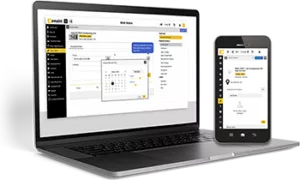What Is Corrective Maintenance?
Corrective maintenance is the process of repairing or restoring equipment and systems after failure or when a defect has been identified. Unlike preventive maintenance, which aims to prevent failures before they occur, corrective maintenance addresses issues as they arise with the goal of restoring machinery to proper working order.
Corrective maintenance can be either planned or unplanned:
- Planned corrective maintenance: Involves scheduling repairs after identifying critical issues during inspections or routine checks. Corrective maintenance can only be planned when repair is not immediately necessary, but still needs to be completed in a timely fashion.
- Unplanned corrective maintenance: Occurs in response to unexpected failures, requiring immediate attention to restore functionality.
Both planned and unplanned corrective maintenance are essential for dealing with unforeseen problems and ensuring the continuous operation of equipment and systems. Corrective maintenance plays a critical role in maintaining productivity and minimizing downtime, especially when unexpected issues arise.
When to Perform Corrective Maintenance
Identifying the need for corrective maintenance involves regular monitoring and inspections of equipment and systems. Here’s how to identify a need for corrective maintenance and when to use it:
How to Identify the Need for Corrective Maintenance:
- Regular inspections: Conduct routine checks and inspections to identify any signs of wear, damage, or malfunction.
- Performance monitoring: Use sensors and monitoring tools to track equipment performance and detect abnormalities or declines in efficiency.
- Failure reports: Analyze historical data and failure reports to identify patterns and predict potential issues.
Picking the Right Time for Corrective Maintenance
Even if you know you need to perform corrective maintenance, it may not need to be completed immediately. The timing depends on the nature and severity of the problem. Here are a few common scenarios:
- After failure detection: When a failure or defect is identified during routine inspections or monitoring, corrective maintenance should be scheduled based on the urgency of the issue, the risk to employee safety if left uncompleted, and the potential for further damage to equipment.
- Post-breakdown: If equipment fails unexpectedly and can no longer function as needed, immediate corrective maintenance is required to restore functionality and minimize downtime.
- End-of-life components: When components reach the end of their useful life and fail, corrective maintenance ensures their timely replacement.
By identifying issues early and promptly addressing them, organizations can minimize the impact of equipment failures and maintain operational efficiency. Using a computerized maintenance management system (CMMS) can help organize and schedule corrective maintenance work orders to ensure maintenance is completed at the right time.
Types of Corrective Maintenance and Examples
Corrective maintenance can be categorized into two types based on the nature of the maintenance activities and the urgency of the repairs. Both types of corrective maintenance can be applied to various industries and applications. Here are the main types of corrective maintenance and examples of corrective maintenance tasks:
Deferred Corrective Maintenance
This type of corrective maintenance is scheduled to occur later instead of being performed right away. The repairs may be deferred and scheduled for a later date because you are waiting on the correct parts or personnel to become available. Corrective maintenance may also be scheduled to be completed during a planned maintenance window, while the machine will already be down for other maintenance.
Here are some common examples of deferred corrective maintenance:
- Minor leak repair: Fixing a small oil leak on a hydraulic system that isn’t affecting performance, deferred until replacement seals are in stock.
- Damaged insulation repair: Repairing torn insulation on a pipe that poses no immediate safety or performance risk.
- Changing a filter: Delaying filter replacement while waiting for backordered filters to be delivered, while the machine is still running as expected.
- Belt replacement: Waiting to replace a frayed, but still functional, conveyor belt until the next planned downtime.
Immediate Corrective Maintenance
Immediate, or unplanned, corrective maintenance is used for urgent repairs that must be carried out immediately to prevent significant downtime or safety hazards. This type of maintenance requires immediate attention. Some examples of immediate corrective maintenance are:
- Machinery repairs: Repairing a malfunctioning CNC machine in a manufacturing plant to restore production capabilities.
- HVAC system fixes: Addressing a faulty air conditioning unit in an office building to ensure a comfortable working environment.
- Electrical system repairs: Replacing a blown fuse or repairing a damaged electrical circuit to restore power in a facility.
- Vehicle maintenance: Fixing a broken-down forklift in a warehouse to ensure materials can be moved efficiently.
- IT equipment repairs: Replacing a failed hard drive in a server to restore data access and prevent downtime.
Corrective Maintenance vs. Other Maintenance Strategies
Corrective maintenance is only one maintenance strategy. Other strategies, like preventive maintenance or predictive maintenance, are other options.
Preventive maintenance involves performing regularly scheduled maintenance on assets to reduce the chance of failures. This method helps avoid the need for corrective maintenance and includes tasks like changing filters, greasing bearings, or other types of maintenance that can keep assets running smoothly for longer.
Predictive maintenance uses sensors, imagers, and other tools to help predict failures that may occur if left unchecked. For example, a sensor may show that a machine is vibrating more than usual and needs to be realigned. Even though the machine hasn’t failed yet, predictive maintenance can help teams identify which actions should be taken to correct problems before they lead to failure.
To decide when to use corrective maintenance, assess the equipment’s importance or criticality. For non-critical assets, corrective maintenance may be the most cost-effective maintenance strategy. However, for critical systems, predictive or preventive maintenance strategies could be a better choice to minimize downtime. A CMMS can help prioritize repairs based on their urgency and impact.
Benefits and Disadvantages of Corrective Maintenance
Corrective maintenance can be beneficial in some scenarios, but it isn’t always the best approach. Understanding the benefits and disadvantages of this maintenance strategy can help organizations make informed decisions about when to use corrective maintenance alongside other maintenance approaches.
Benefits of Corrective Maintenance
Since corrective maintenance focuses on getting assets working properly, it has many benefits:
- Immediate issue resolution: Corrective maintenance addresses problems as they arise, ensuring that equipment is quickly restored to working condition.
- Reduced planning needs: Since it is performed after a failure is detected, corrective maintenance requires less upfront planning compared to preventive maintenance.
- Cost-effectiveness for non-critical systems: Corrective maintenance can be more cost-effective than implementing comprehensive preventive maintenance programs for equipment that is not critical for production.
Disadvantages of Corrective Maintenance
While corrective maintenance can be the best maintenance strategy for certain types of assets, relying on it as your sole strategy can have negative impacts on the overall reliability of your plant. Some of its disadvantages include:
- Increased downtime: Unplanned corrective maintenance can lead to significant downtime, impacting productivity and operational efficiency.
- Higher costs for critical failures: Unexpected failures in critical systems can result in high repair costs, emergency service fees, and potential production losses.
- Resource allocation challenges: Immediate corrective maintenance may require rapid allocation of resources, which can disrupt planned activities and strain maintenance teams.
- Safety risks: Sudden equipment failures can pose safety hazards to personnel and may lead to accidents or injuries.
By weighing these benefits and disadvantages, organizations can determine the appropriate balance between corrective and preventive maintenance strategies to optimize their maintenance programs.
How to Reduce Corrective Maintenance
Corrective maintenance isn’t the best strategy for every asset. Reducing reliance on corrective maintenance involves shifting away from reactive maintenance strategies to focus on more proactive strategies.
If your company wants to begin shifting towards more proactive maintenance, here are several actions you can take:
Implement a Preventive Maintenance Program
One of the most straightforward ways to reduce corrective maintenance is by building a preventive maintenance schedule. Regular tasks like lubrication, inspection, calibration, and part replacement help catch wear and tear before it results in failure. By sticking to a consistent schedule, teams can address minor issues before they escalate.
Leverage Predictive Maintenance Technologies
Predictive maintenance takes things a step further by using real-time data to monitor equipment health. Tools like thermal imagers and vibration analyzers can identify early warning signs, such as overheating or imbalance, so maintenance teams can intervene before a breakdown occurs.
Standardize Maintenance Procedures
Inconsistent practices can lead to overlooked issues or premature failures. Standardizing procedures through clear checklists, standardized procedures, and job plans helps ensure that every technician performs tasks the right way, every time. This consistency reduces the chance of human error and improves the overall effectiveness of both preventive and corrective maintenance efforts.
Use a CMMS to Track and Schedule Work
A computerized maintenance management system helps organize all aspects of maintenance, from scheduling and asset tracking to failure history and performance metrics. With a CMMS, teams can identify recurring issues, automate preventive tasks, and ensure accountability. Over time, this visibility helps reduce the volume of unexpected breakdowns.
Perform Root Cause Analysis
Fixing the symptom of a problem without addressing its root cause can lead to repeated failures. When a piece of equipment breaks down, conducting a root cause analysis helps identify the underlying issue. Whether it’s a design flaw, a misaligned shaft, or an environmental factor, correcting the true cause can eliminate the need for future corrective maintenance.
Analyze Failure Data
Reviewing historical failure data can uncover valuable insights into patterns and problem areas. Teams can use this information to fine-tune preventive maintenance schedules, justify equipment upgrades, or identify process changes that reduce wear.
Managing Corrective Maintenance With a CMMS
A computerized maintenance management system (CMMS) is a specialized software solution for managing corrective maintenance activities effectively.
Organizations that use a CMMS see increased efficiency, reduced machine downtime, and improved maintenance response times when unplanned breakdowns happen. A CMMS also enables comprehensive reporting and analytics, which provide valuable insights for optimizing maintenance strategies and preventing future failures.
Here are five CMMS features that can enhance corrective maintenance management:
- Centralized maintenance data. A CMMS centralizes all maintenance-related data, including failure reports, work orders, and equipment history, making it easy to track and manage corrective maintenance activities.
- Automated work order creation and management. A CMMS can automatically generate work orders when a failure is detected, ensuring prompt attention to issues. The software can also track the progress of work orders from creation to completion, providing visibility into the status of corrective maintenance tasks.
- Real-time monitoring and alerts. The software is designed to integrate with sensors and monitoring systems to detect equipment issues in real time. When anomalies are detected, the CMMS can send alerts and notifications to maintenance teams, enabling quick response times.
- Resource allocation. A CMMS helps allocate the right personnel and tools for corrective maintenance tasks, ensuring efficient use of resources. It can also track inventory levels of spare parts and materials, ensuring availability for immediate repairs.
- Mobile access. Most CMMS programs offer a mobile app, allowing maintenance personnel to access work orders, equipment information, and failure data on the go, enhancing flexibility and efficiency.
By leveraging a CMMS such as eMaint for corrective maintenance, organizations can enhance their maintenance processes, ensure quick resolution of issues, and maintain high levels of operational efficiency and reliability.
To learn more about what a CMMS can do for your organization, speak with a specialist or try a free demo of eMaint today.



